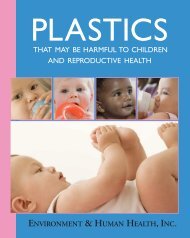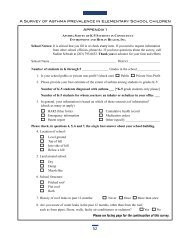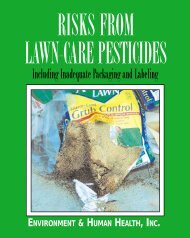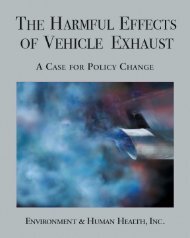LEED Report - Environment & Human Health, Inc.
LEED Report - Environment & Human Health, Inc.
LEED Report - Environment & Human Health, Inc.
- No tags were found...
Create successful ePaper yourself
Turn your PDF publications into a flip-book with our unique Google optimized e-Paper software.
The Green Building DebateLead can cause irreversible neurological damage, renal (kidney) disease,cardiovascular effects and reproductive toxicity. Blood lead levels oncebelieved to be safe are now considered hazardous, with no knownthreshold.In addition to concerns about exposures to chemicals in the crumbrubber, some synthetic turf contains antimicrobial agents used tominimize bacterial growth. 52Additional health and environmental concerns surrounding artificialturf include:■ Worker Exposure: <strong>Health</strong> data from workers in rubberfabrication and reclamation industries indicate the presenceof VOCs, semi-volatile hydrocarbons and harmful particulatesin the air. Occupational studies reveal health effects rangingfrom severe skin, eye and respiratory irritation to threekinds of cancer. Companies that manufacture and supplysynthetic turf are responsible for assessing the risks tohumans. The previous case study about PFOAs demonstratesthat it may be decades before these data are revealed andreviewed.■ Disposal: Most synthetic turf needs to be replaced after about10 years, yet the turf is not biodegradable. Most synthetic turffields are composed of crumb rubber infill made from recycledtires. Used tires have been banned by landfills in all but eightstates, partly because of concerns about the risk of tire fires,which release toxicants such as arsenic, cadmium, lead, nickel,PAHs and VOCs. 53Most synthetic turf needsto be replaced afterabout 10 years,yet the turf is notbiodegradable. Mostsynthetic turf fields arecomposed of crumbrubber infill made fromrecycled tires. Used tireshave been bannedby landfills in allbut eight states....■Heat Island Effect: Replacing natural turf with artificial turfcontributes to the “urban heat island effect” by absorbingsunlight and emitting heat. Urban heat islands increasedemand for energy (particularly air conditioning), intensify air39







